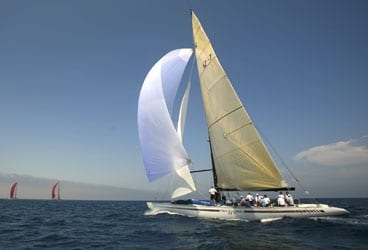
KZ7Pedrick
International racing of another form is taking place in the America’s Cup city of Valencia this week as 14 Twelve Metre Class yachts line up for the first of several regattas to celebrate the one-hundredth year of the Class. Competing in three divisions based on design era, the Twelves will race a seven-race series from June 14-17 as the two pairs of America’s Cup Class yachts for Alinghi and Emirates Team New Zealand train nearby for the America’s Cup Match beginning in another week.The Twelve Metre Class Rule was revised before the America’s Cup Jubilee in Cowes, UK in 2001 so that yachts spanning nearly a century (at that time) could race among similar vintages, with age credits for all but the Grand Prix Division. This division is open to all, but is effectively for the winged-keel America’s Cup fleet of 1987 plus “Australia II” (the 1983 breakthrough design). The only new Twelve built since 1987 is a replica of a Classic Twelve from the earliest years. The Classic Division is defined as having keel-hung rudders, pre-dating “Intrepid” in 1967, which initiated the separated rudder aft with a trim tab on a reduced-size keel. The Classics race together, although among three subdivisions – the America’s Cup era of 1958-67, the Pre-World-War II years of 1933-39, when many Twelves were built, and pre-1933, when an earlier version of the Class Rule compromised keel design. Age credits help equalize the performance among the Classics.The Division from “Intrepid” to “Australia II,” having separate rudders, also receives age credits to help mitigate design obsolescence during those years. Yachts in this division are called the Moderns – it’s all relative when the Class is 100 years old.Looking back to 1906, there were scattered rating rules in Europe, making it difficult for yachts of different countries to compete equitably. Delegates of a number of nations met in London during 1906 to create a rating rule that would offer unified design and racing. They produced a common rating formula and associated descriptions to cover a range of yacht sizes that would level-race in classes of 6, 8, 10, 12, 15, 18 and 23 “meters.” Being the first international rule for yacht rating, it was called just that – the International Rule.Of course, racing among multiple nations needed an organizational structure, and a subsequent conference was held in Paris on 1907, establishing the International Yacht Racing Union, now re-named ISAF (the International Sailing Federation). With racing of International Rule yachts starting in 1907, as well, 2007 is the centennial year of these classes. Also having active international fleets today, the Sixes will celebrate in Cowes, and the Eights in Scotland, during the summer.Fourteen Twelves have gathered here in Valencia for this week’s regatta. In the Grand Prix Division are the three “Plastic Fantastics” of the 1987 Team New Zealand and “South Australia.” Three Moderns and seven Classics round out the fleet. Concentrations of yachts have come from the south of France, northern Europe and the United States. Med-moored in a row, side-by-side and generally by age, it’s an extraordinary collection of well-kept yachts that have gathered mostly for friendly racing, but the Concours d’Elegance makes quite a sight. Grand Prix:Hissar KZ-5 USA 1985Kiwi Magic KZ-7 USA 1986South Australia KA-8 France 1985Wright on White KZ-3 Brazil 1985Modern:Challenge 12 KA-10 France 1985Freedom US-30 USA 1979Valiant US-24 USA 1970Classic:Emilia I-2 Italy 1930Ikra K-3 France 1964Sovereign K-12 France 1963Trivia K-10 Germany 1937Vanity V K-5 Germany 1936Wings K-15 United Kingdom 1937Zinita NED-1 Netherlands 1927These yachts will be joined later in the summer by additional Twelves for a series of three events in Porto Cervo, Cannes and St. Tropez, when 20 or more Twelves are expected to compete. With about 180 Twelves built between 1907 and 1987, of which more than 100 survive, this will be more than 10% of all Twelves ever built, and more than 20% of those in active service. The Cannes regatta, in late September, will be the Centennial World Championship of the Class.Further information about the Valencia Twelve Metre Regatta and the Class itself can be found on the website of the International Twelve Metre Association via the following link:









